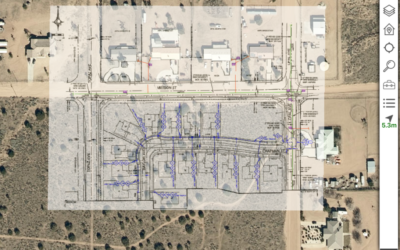Companies can convert massive amounts of raw imagery into usable data that fuels multiple enterprise systems
The explosion of machine learning for businesses
Machine learning (ML), a subset of artificial intelligence, has exploded in daily use across markets and geographies. The global machine learning market was valued at USD 36.73 billion in 2022 and is expected to grow at a compound annual growth rate (CAGR) of 34.8% from 2023 to 2030.Yet many companies, especially asset-intensive businesses like utilities, struggle to see the value it brings to managing networks and optimizing operations. Simply put—they don’t see the potential edge cases that can improve core business functions. Moreover, they lack the resources and technical capabilities to build, train, and test models.
But the potential exists and is exciting to contemplate. Modern geospatial technology combined with machine learning offers a new level of scalability previously unheard of. It can remove mundane and time-consuming activities from staff while generating and enhancing massive amounts of infrastructure data available for multiple systems and uses.
Specifically, by combining ML with computer vision (CV) technology and location intelligence, companies can automate manual processes to detect, capture, and classify features from massive raw data stores, including satellite imagery, surveillance cameras, or drones. These data sources can be created or enhanced for use in multiple enterprise systems, from ERP to work management, enterprise asset management, GIS, and more.
More data than data analysts
More utilities today are initiating digital transformation initiatives, yet many have yet to understand how machine learning can benefit the business, specifically operations and GIS-based processes.
They have adopted AI for consumer-oriented applications, including chat boxes. But more substantive applications have yet to be embraced, though the demand is there. For example, with the release of Esri ArcGIS Utility Network (UN), you can trace your transmission equipment through your regulator stations or substations to your distribution system for the first time. With the ability to do that, organizations realize their data may lack the quality and detail to effectively deploy the UN’s powerful capabilities.
Utilities are constantly gathering data, whether drone imagery, remotely sensed data of transmission lines, or street view imagery of overhead assets. They often collect data faster than they can process. This results in unused data for asset management and enriching their existing GIS database.
The combination of ML and CV presents a tremendous opportunity to take advantage of data in new and exciting ways. Companies can apply ML and CV to train models to detect objects or anomalies in images taken. For example, images taken for vegetation management can be used for multiple purposes when combined with other existing data sets.
The challenges to employing location-based ML:
- Acquiring the right expertise and experience
- Building combined ML and CV capabilities
- Training models for business use cases
- Thoroughly testing and validating models and outputs
- Transforming imagery into intelligence
Machine learning and computer vision technology
ML uses algorithms to deconstruct and analyze massive volumes of data, learn from it, detect patterns, and make decisions or predictions based on those patterns. For electric, gas, and water utilities, oil and gas, and other asset-intensive businesses, these capabilities matter more than ever because of the explosion of data available now being collected by drones and other remote sensing techniques.
In addition to ML, the CV industry and technology have evolved. It can identify and understand objects and people in images and videos. Like machine learning, CV seeks to perform and automate tasks replicating human capabilities. Social media and search have traditionally used it to detect similar faces on posts and news alerts.
What’s exciting is the application of ML and CV to asset-intensive processes. The concept is simple—instead of using CV to identify a face, you use it to identify an asset, starting at a large scale and moving to a much more granular state from the raw data. Utilities can then apply ML to detect, capture, and classify these assets as features and attributes.
For example, you can capture data around assets such as a gas regulator station, represented as a location point in a traditional database. Now that point can represent all devices, pipelines, and related objects, including attribute records. If there’s a detectable bar code, computer vision can digitally match it to an item in an asset management system.
In another example, companies need boots on the ground to inspect and update data, whether it’s Esri’s ArcGIS Utility Network or other high-fidelity databases that closely track your assets. If you have hundreds or even thousands of regulator stations throughout an area of operations, and it takes 10 hours to manually create all the objects that the UN or other databases need, It’s time-consuming and expensive.
With ML and CV, you can autodetect massive numbers of utility-specific devices, structures, and objects at an unprecedented speed, scale, and accuracy. You remove that prohibitive factor by using innovative technologies that can improve your geodatabases and other enterprise systems of record used to manage assets.
This proves valuable in two key areas. First, organizations that have good data but must continuously update and maintain it. You can use CV to detect anomalies on pipelines or other assets at a large scale so that shortly after data collection, routines can be run to limit the amount of manual effort required.
Second, companies can benefit from data not yet captured. Organizations can employ drones and satellite imagery and then process it quickly and efficiently. Security camera footage can be processed and leveraged as well.
In either case, companies can automate processes, save time, lower costs, and replace manual, tedious work activities so dedicated staff can perform higher-value work. And from a pure competitive advantage—organizations can take a proactive approach in adopting technology to solve problems today and into the future.
Your geospatial ML partner
For companies looking to take advantage of these capabilities yet wondering where and how to start, Locana can help. Locana maintains staff and resources dedicated to applying leading-edge innovation to today’s industry challenges and opportunities. These technology experts and geospatial specialists work to develop and innovate in ways that benefit utility and asset-intensive customers. They possess deep technical knowledge through project work that’s honed to focus on achieving business results.
Through a tested and proven set of assessment protocols, repeatable patterns, and tested best practices, our innovation experts will develop customized applications that capture massive stores of raw data using AI-based technology, including ML, CV, and more. You’ll be able to take advantage of previously unusable data in record time and without draining finite resources in the processes. Moreover, you’ll be set up to process more imagery and remote sensing data using the latest technology trends, which can fuel your multiple enterprise systems.
Bring location-based ML to your organization
For utilities of every kind, the exponential growth of data provides tremendous opportunity. ML and CV allow more data to be processed faster, at lower costs, and with greater accuracy. Organizations can automate processes to create and enhance massive volumes of data to fuel their GIS, ERP, WMS, EAM (Enterprise Asset Management), and other enterprise systems. Businesses can make better decisions across departments to improve networks, operations, business services, and more. Locana has a unique set of expertise and high-tech experience to deliver applications at the edge of innovation.
***
Want to learn more about how you can gain a competitive advantage with machine learning and location-based AI? Visit our innovation and services pages.


